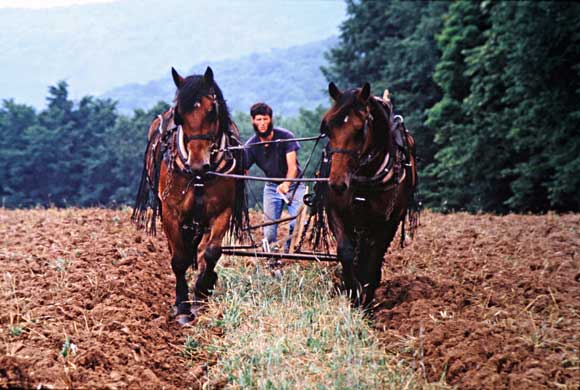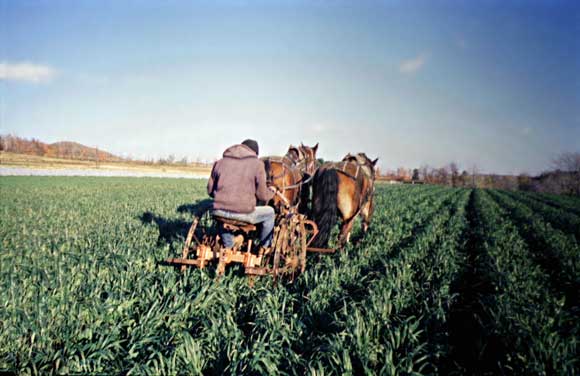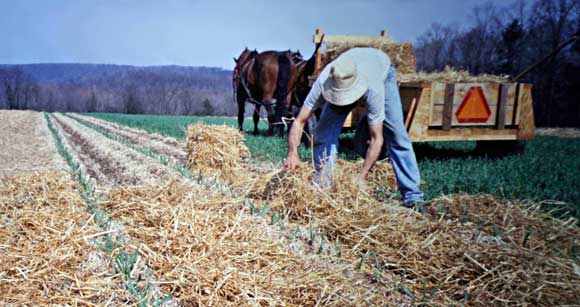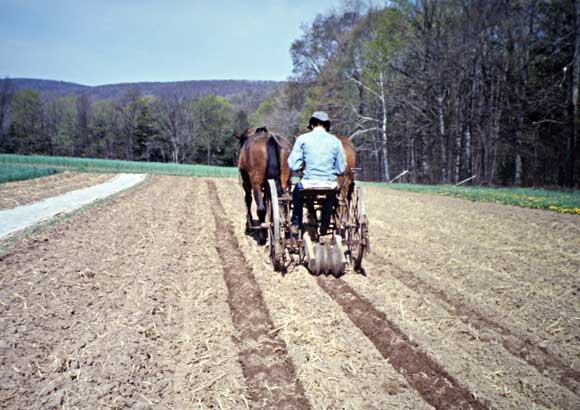Horse Powered Market Gardening Economics
The Cost of Using Horses

Please keep in mind that this small survey is not meant to be representative of the current horsepowered vegetable industry. There are now thousands of acres of wholesale produce grown in Plain communities across the United States and Canada. The teamsters in this horse accounting project make their living from small-scale, organic market gardens (2-5 acres of vegetables) selling directly to the customer via CSAs, farmers markets and restaurants.
| Total Teamster Hours | 559 |
| Horse maintenance Expenses | $4050 |
| Cost per Teamster Hour | $8.11 |
| Teamster Hours per Acre of Vebetable Production | 61 |
| Harness Hours | 117 |
| Horse Maintenance Hours | 510 |
| Cost per Horse | $1,750 |
| Horse Drawn Equipment | $9,675 |
| Horse Maintenance as a percentage of Total Farm Expenses | 5.5% |
| Horse Expenses as a percentage of Gross Farm Income | 3.6% |

Due to the small size of our operations, hours spent on horse-powered fieldwork
turned out to be relatively low. Teamster time, including vegetable production,
woods work, hay making, pasture management, farmstead maintenance and horse training,
ranged from 229 to 1,303 hours across the four farms with an average of 559 hours.
Horse maintenance expenses ranged from $984 to $8,262, averaging $4,050. That is,
it cost the teamsters in this project anywhere from $4.30 to $14.40 in out-of-pocket
horse expenses for every hour of fieldwork with an average of $8.11 per hour.
When I initiated this number-crunching exercise, I assumed that the farm with the most
work horse hours would have the lowest cost per teamster hour. As it turned out, the
farm with the fewest hours of fieldwork had the lowest cost per teamster hour ($4.60)
due to extremely low work horse expenses ($984 for three horses).
This was the only farm in the study that produced all of its horse hay, grain and bedding.
Topping the list of horse expenses was fertilizer ($377), veterinary ($224), baler twine
($95), fuel ($90) and seed ($89). This teamster uses a small tractor for combining the
small grains and baling hay and straw. He and his wife invested almost 90 hours growing
and harvesting the horse feed and bedding — 50 hours of teamster time and 38 hours on
the tractor, stacking hay in the barn and other non-teamster tasks.
The farm with the second lowest cost per teamster hour ($6.34) had the most teamster hours
(1,303) but also the highest horse expenses ($8,262 for five horses). This farm generated
by far the highest produce sales of the group, almost $130,000 from 3-1/2 acres.
This teamster and crew of two to three interns invested 123 hours of teamster putting up
loose hay for the work animals. Their top horse expenses were for bedding ($1,479), minerals
($1,417), farrier ($1,200), veterinary ($1,188), grain ($1,158) and purchased hay ($816
which included the cost for pasture rental).
The other two farms in the horse accounting project had very similar hose maintenance
expenses ($3,386 for three midsized crossbreds and $3,559 for four small Fjords) with
the biggest outlay for hay ($518 and $780), grain ($461 and $842), bedding ($747 and
$442) and fertilizer ($674 and 0). Due to the big difference in teamster hours (457
versus 247), horse costs per teamster hour varied by a factor of almost two ($7.41
versus ($14.40).
Keep in mind that the cost per teamster hour is not the best measure for comparing
horse powered systems because it does not give any indication of teamster productivity
or efficiency. In this study, teamster time for vegetable production ranged from 23
hours per acre to 122 hours per acre with an average of 61 hours per acre. Although
there was a strong correlation between increasing h o r s e p o w e r e d fieldwork
and higher gross return per acre, our economic analysis was not comp r e h e n s i v e
enough to explain the connection or to show if putting in fewer teamster hours
necessarily resulted in more overall labor for the market garden such as hand
weeding, harvesting and planting.

The primary utility for determining the cost per teamster per hour is for putting
together enterprise budgets. For example, when developing a carrot budget for our
farm we were able to put a price tag on all aspects of production except the cost
of using the horses. We kept track of the fieldwork, close to 12 hours of teamster
time for the quarter-acre. Now that we know our cost per teamster hour ($7.41),
we could fill in this missing budget item: $88.92 in horse expenses for growing
the carrots.
As for putting together a business plan, the ratio between horse costs and total
farm expenses may be more helpful. Out-of-pocket horse expenses averaged 5.5
percent of total farm costs for the four farms in the project. There was a
substantial spread for this number, from 2.3 percent of farm expenses to 8.4
percent. Likewise, the gap was pretty wide for horse costs as a percentage of
gross farm income (1.5 – 6.4 percent, average 3.6 percent), partly due to the
large disparity in gross income ($65,282 - $177,000 — the latter including
income from a 20-cow dairy).
Across the board, horse expenses represented such a small percent of total
farm expenses and gross income that it would be safe to say that other costs,
such as hired labor and farm supplies, affected profitability more than the
expense of maintaining the work animals. Net income, determined by 2006 –
2010 Schedule F reports, ranged from $20,000 - $40,000 with an average of $30,368.
Horse expenses could have a much bigger impact on net income if capital and labor
costs were included. For practical and philosophical reasons, this group of
teamsters decided not to put a dollar value on labor for horse maintenance.
Even so, the real eye opener of this study was realizing that we spent as much
time working for our horses as they did for us. Horse maintenance labor as a
percentage of teamster hours ranged from 69 - 172 percent with an average of
107 percent!
Horse maintenance hours averaged 510 hours per farm (136 hours per horse)
with a spread from 315 hours (105 hours/horse) to 1,059 hours (212 hours/horse).
Daily chores (182 – 795 hours/farm, average 350) and cleaning stalls (16 -
160 hours, average 94) consumed most of this horse care time. These aspects
of horse maintenance labor may be on the high side because all of the teamsters
in this survey stable their work force a substantial portion of every day to
collect enough manure for fertilizing the market garden. For the same reason,
feed and bedding expenses may be higher than necessary.

This teamsters union also voted to put the time spent on grooming and
harnessing/unharnessing the horses on the teamster’s time clock rather
than the horse maintenance stop watch. Harness time (59-248 hours per farm,
average 117) represented 17-65 percent of teamster hours (average 35 percent).
This inefficiency may be partly explained by the nature of market garden
fieldwork resulting in relatively short work sessions. We also decided not
to include horse related capital investments in this study because these
fixed costs varied so much from farm to farm and, in most cases, had been
paid off or completely depreciated long before the start of this horse
accounting project. For those interested in adding these numbers to the
economic analysis, the purchase price of work horses ranged from $1,800
to $13,000 per farm (average: $1,750 per horse) and $500 to $1,500 per
farm for harness (average: $268 per harness).
Horse drawn equipment collected over the years and currently in use for
vegetable, hay and grain production averaged $9,675 with a spread from
$5,540 to $13,350. Buildings covered the spectrum from a 12-by-24-foot
run-in shed to a 65-by-98-foot bank barn while the land base for horse
hay, grain and pasture varied from 2 to 22 acres (average 14).
Depending on one’s location, any one of these upfront costs could be a major
investment. Adding these capital costs (amortized over 15 years) and the labor
bill for work horse maintenance to the budget could easily double work horse
expenses.
In summary, this small survey shows that horse powered market gardening can
be profitable because out-of-pocket horse maintenance costs represent a small
percentage of total farm expenses. If capital costs and labor for horse
maintenance are annual cash expenses, then total work horse costs may become
a significant factor in the vegetable farm’s net income unless the majority
of feed and bedding are produced on the farm, the efficiency of daily chores
and harnessing is made a priority, and financial credit is given for the
horse manure used for fertilizing the market garden.
| Cedar Mountain | Maple Hill | Beech Grove | Average | |
| Manure Spreader | 73.5 | 69 | 39.75 | 61 |
| Primary Tillage | 40 | 57 | 148.5 | 82 |
| Secondary Tillage | 66.25 | 84 | 109.75 | 87 |
| Cultivation | 14.5 | 19.25 | 48.5 | 27 |
| Planting | 0 | 12.5 | 73.5 | 29 |
Mow and Rake |
15 | 73.5 | 56 | 48 |
| Miscellaneous | 0 | 19.5 | 112 | 44 |
| Total | 209.25 | 334.75 | 588 | 377 |
To illustrate the tradeoffs involved in
trying to implement these cost-saving measures, profiles of each of the four
farms are linked here. Written by each teamster, these farm narratives also
emphasize that the rewards of working with horses are far greater than can be
conveyed by the numbers. Three of the teamsters in this informal study tracked
the time spent on specific farm tasks. For this purpose, individual horse hours
were recorded to highlight the amount of live horsepower used. That is, three
hours plowing with two horses was recorded as six horse hours of primary tillage
while one hour discing with three abreast was tracked as three horse hours of
secondary tillage. Unlike teamster hours, harness time was not included in the
horse hours accounting. So-called “non-productive work,” such as
commuting to the fields or when the team is hitched to the manure spreader or
harvest wagon while it is loaded, was dutifully recorded for both teamster and
individual horse hours.
![]()
December 2014/January 2015 issue of Rural Heritage magazine.
